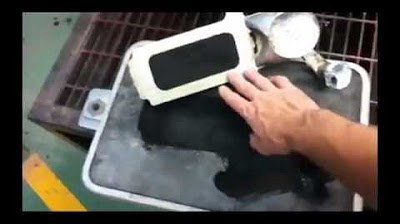[ Sand Casting ] - Learn More about Sand Casting Process
Summary
TLDRThe video outlines the sand casting process, a widely used method in metal manufacturing due to its high resistance to elevated temperatures. It describes the steps involved, starting with the placement of a pattern in a drag box filled with sand, followed by ramming and leveling. The process includes turning the box over, positioning a cope box, and filling it with sand. After forming gates and sprues, molten metal is poured into the mold and allowed to cool before the final casting is removed. This method is essential for producing various industrial components, including engine blocks and valves.
Takeaways
- 😀 Sand casting is a widely used manufacturing process for creating metal products.
- 🔥 Sand is highly resistant to elevated temperatures, making it ideal for metal casting.
- 🔩 Almost all metal casting materials can be utilized in sand casting.
- 📏 Sand castings can vary significantly in size, from small components to very large structures.
- 🚗 Examples of products made using sand casting include engine blocks, machine tool bases, and cylinder heads.
- 🔄 The sand casting process begins with setting up an inverted drag box on a clean floor.
- 🛠️ A pattern is placed inside the drag box, which is then filled with sand and rammed tightly.
- ⚙️ After filling, the drag box is inverted, and a cope box is placed over it to complete the mold.
- 🔧 The two halves of the pattern are aligned, and sand is added to form the mold securely.
- 🔥 Molten metal is poured into the mold through formed gates and sprues, and allowed to cool before removal.
Q & A
What is sand casting?
-Sand casting is a metal manufacturing process that uses sand as the primary mold material to create metal products.
Why is sand used in the casting process?
-Sand is used because it is highly resistant to elevated temperatures, making it suitable for casting various metals.
What types of products can be made using sand casting?
-Products that can be made using sand casting include engine blocks, machine tool bases, cylinder heads, pump housings, and valves.
What are the initial steps in the sand casting process?
-The initial steps involve setting an inverted drag box on a clean floor, placing the pattern inside, and pouring sand into the box.
What happens after the sand is poured into the drag box?
-After the sand is poured, it is rammed and leveled to create a compact mold.
How is the cope box utilized in the sand casting process?
-The cope box is placed over the packed drag box to form the top half of the mold, allowing for the placement of the second half of the pattern.
What is the purpose of the screws during the pattern removal?
-Screws are used to assist in removing the pattern from the mold after both boxes are opened.
What steps are taken to ensure the upper box does not float?
-After the patterns are removed, the boxes are clamped together with rivets to prevent the upper box from floating during the metal pouring.
What is done after the molten metal is poured into the mold?
-The molten metal is allowed to cool down before the final cast is removed from the mold.
What are gates and sprues in the context of sand casting?
-Gates and sprues are channels formed in the mold to allow the molten metal to flow into the mold cavity.
Outlines

此内容仅限付费用户访问。 请升级后访问。
立即升级Mindmap

此内容仅限付费用户访问。 请升级后访问。
立即升级Keywords

此内容仅限付费用户访问。 请升级后访问。
立即升级Highlights

此内容仅限付费用户访问。 请升级后访问。
立即升级Transcripts

此内容仅限付费用户访问。 请升级后访问。
立即升级5.0 / 5 (0 votes)






